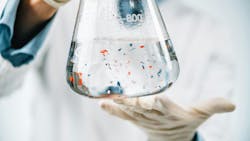Getting started on microplastics: A contaminant unlike any other
As per- and polyfluoroalkyl substances (PFAS) are taking the spotlight as the high-profile contaminant, conversations surrounding microplastics are quickly on the rise. Testing, piloting and treatment for PFAS has just begun, but water professionals feel the looming presence of microplastics on the horizon. Like PFAS, microplastics come in many forms, with different compounds, sizes and masses.
Microplastics could very well be the next big thing, but work on effectively removing the contaminant from drinking water has just begun.
Brent Alspach, PE, BCEE, director of applied research at Arcadis, gave a presentation at American Water Works Association’s (AWWAs) 2025 Annual Conference & Exposition (ACE) in Denver, Colorado, on profiling water treatment plants for microplastics removal.
The session focused on studying microplastics in drinking water via Alspach’s shared findings from the Water Research Foundation (WRFs) “Developing Strategic Consumer Messaging for Microplastics in Drinking Water Supplies” project (5155), which involved a multi-utility pilot program with 16 water systems across the U.S. Goals of the project included profiling microplastics through the treatment process, understanding removal efficiency and informing facility design and operations. The 16 water systems spanned across traditional and advanced treatment systems with varied source waters.
“Profiling these key processes is a very significant challenge,” Alspach said, “not just for academic projects, but for real-world utilities.”
A total of 153 samples were planned across utilities. One of the challenges of the project was developing sampling criteria, as well as developing new equipment that could properly run the tests. Another worry was the quality assurance and quality control of the samples. Microplastics can show up in synthetic clothing, plastic lab equipment and in the air, which can all influence test results.
Alspach stated that each sample, on average, takes four hours to perform. Across the 153 samples to be collected, this would take dedicated staff months of full-time effort to complete.
Hundreds of variables can influence the behavior of microplastics, including flocculation conditions, filtration media, membrane pore sizes, operation modes and cleaning cycles.
Alspach emphasized the need for simplified, standardized sampling protocols moving forward. He also stated the importance of cost-effective and scalable lab methods.
Microplastics come in many shapes and sizes and share only a few attributes with other contaminants such as enumeration and mass concentration.
Alspach called for an industry-wide consensus on which plastics to measure based on relevance to health and treatment. Once key targets are identified, measurement can be more focused and cost-effective.
“To regulate microplastics, we must first decide which to measure,” Alspach said, “then build simpler, cheaper ways to sample and analyze them.”
About the Author
Alex Cossin
Associate Editor
Alex Cossin is the associate editor for Waterworld Magazine, Wastewater Digest and Stormwater Solutions, which compose the Endeavor Business Media Water Group. Cossin graduated from Kent State University in 2018 with a Bachelor of Science in Journalism. Cossin can be reached at [email protected].

